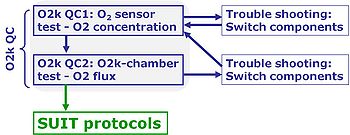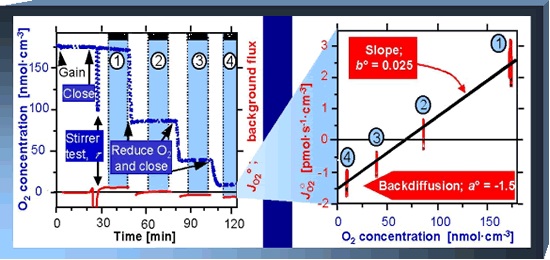Difference between revisions of "MiPNet14.06 Instrumental O2 background"
| Line 1: | Line 1: | ||
{{OROBOROS header page name}} | |||
{{Publication | {{Publication | ||
|title=[[Image:O2k-Protocols.jpg|right|80px|link=O2k-Protocols|O2k-Protocols]] O2k Quality Control 2: Instrumental oxygen background correction and accuracy of oxygen flux. [[Media:MiPNet14.06 InstrumentalO2Background.pdf |»Bioblast pdf«]] | |title=[[Image:O2k-Protocols.jpg|right|80px|link=O2k-Protocols|O2k-Protocols]] O2k Quality Control 2: Instrumental oxygen background correction and accuracy of oxygen flux. [[Media:MiPNet14.06 InstrumentalO2Background.pdf |»Bioblast pdf«]] | ||
| Line 25: | Line 26: | ||
{{Technical support integrated}} | {{Technical support integrated}} | ||
[[ | * First step - O2k Quality Control 1: »[[MiPNet06.03 POS-Calibration-SOP]]« | ||
[[File:O2k-QCS.jpg|350px|O2k-QCS]] | |||
* Second step - O2k Quality Control 2 | |||
[[Image:MiPNet14.06.jpg|frame|Instrumental background experiment, measuring oxygen flux without biological sample at four oxygen levels (left), and linear relation between instrumental background oxygen flux and oxygen concentration (right). Modified after: Gnaiger E (2001).]] | |||
<br /><br /><br /><br /><br /><br /> | |||
* Next step - when measuring cytochrome ''c'' oxidase activity: Autoxidation of ascorbate and TMPD causes a [[MiPNet06.06_ChemicalBackground |chemical background oxygen flux]]. DatLab provides real-time correction for instrumental and chemical background. | |||
== Instrumental oxygen background test for permeabilized muscle fibres == | === Instrumental oxygen background test for permeabilized muscle fibres === | ||
# While biopsy sampling and fibre preparation proceed: Perform air calibration in [[MiR06Cr]], then close the chamber to evaluate instrumental background at air saturation (c. 10 min): This is a quality control of the medium, important under field conditions, where medium preservation (sterility) may be less controlled than in the lab. | |||
# Elevate oxygen concentration to 450-500 µM with oxygen gas ([[Syringe\60 ml\Gas-Injection]]), close and after two to three min perform a [[stirrer test]] (using the automatic stirrer test function of DatLab). This is important, since the [[OroboPOS]] may have a different response time at elevated oxygen concentration. If the response time increases dramatically, then the sensor may even show a non-linear response to oxygen concentration at high oxygen levels. | |||
# While biopsy sampling and fibre preparation proceed: | |||
# Elevate oxygen concentration to 450 µM with oxygen gas ([[Syringe\60 ml\Gas-Injection]]), close and after two to three min perform a [[stirrer test]] (the | |||
# Instrumental background: After 20 min, open the chamber and allow O<sub>2</sub> to drop to c. 350 µM, close for 20 min, open and drop O<sub>2</sub> to c. 250 µM (this should be the lowest experimental O<sub>2</sub> concentration). | # Instrumental background: After 20 min, open the chamber and allow O<sub>2</sub> to drop to c. 350 µM, close for 20 min, open and drop O<sub>2</sub> to c. 250 µM (this should be the lowest experimental O<sub>2</sub> concentration). | ||
# Increase O<sub>2</sub> with H<sub>2</sub>O<sub>2</sub> injection (c. 2 µl) to 400 µM, measure for 15-20 min instrumental background, simulating a re-oxygenation during the experiment. | # Increase O<sub>2</sub> with H<sub>2</sub>O<sub>2</sub> injection (c. 2 µl) to 400 µM, measure for 15-20 min instrumental background, simulating a re-oxygenation during the experiment. | ||
# Increase O<sub>2</sub> with H<sub>2</sub>O<sub>2</sub> injection (c. 1 µl) to 450 µM, until the fibres are added, for equilibrating the instrument at high O<sub>2</sub>. | # Increase O<sub>2</sub> with H<sub>2</sub>O<sub>2</sub> injection (c. 1 µl) to 450-500 µM, until the fibres are added, for equilibrating the instrument at high O<sub>2</sub>. | ||
# Addition of permeabilized fibres into the O2k-Chamber: | # Addition of permeabilized fibres into the O2k-Chamber: » [[Permeabilized muscle fibres]]. | ||
== | === Apparent oxygen flux in closed chamber near air saturation with pure medium === | ||
[[ | The uncorrected slope of the oxygen signal over time in a [[closed chamber]] at air-calibrated oxygen concentration is an important control parameter. It reflects the consumption of oxygen by the [[polarographic oxygen sensor]] ([[POS]]). The theoretical value is calculated by DatLab in the O2 Calibration window (Supplement C in [[MiPNet06.03 POS-Calibration-SOP]]). The theoretical value at 37 °C (O2 slope uncorrected) is usually between 2 and 3 pmol·s<sup>-1</sup>·ml<sup>-1</sup>. The actual values should correspond very closely to the expected slope, i.e. within ± 1 pmol·s<sup>-1</sup>·ml<sup>-1</sup>. | ||
* Values higher than 4-5 pmol·s<sup>-1</sup>·ml<sup>-1</sup> at 37 °C may therefore indicate a [[biological contamination]] in the chamber or in the medium. | |||
* Lower values may indicate: | |||
# Air bubbles in the closed chamber: switch on the internal illumination of the O2k and inspect the chamber through the front window. Remove any air bubbles. | |||
# A large volume of medium collected in the receptacle of the stopper: siphon off any medium. | |||
# A larger chamber volume: check [[chamber volume calibration]]. | |||
# If an O2k-MultiSensor stopper with multiple ports is used, it is particularly important to siphon off excess liquid from top of stopper. Any convection of liquid must be avoided, which otherwise results in an apparently leaky chamber. | |||
[ | === Excel templates === | ||
:» [http://www.oroboros.at/?BackgroundCorrection '''Excel Templates and DatLab-Demo Files'''] | |||
== References == | |||
: | * Gnaiger E, Steinlechner-Maran R, Méndez G, Eberl T, Margreiter R (1995) Control of mitochondrial and cellular respiration by oxygen. J Bioenerg Biomembr 27:583-96. - [[Gnaiger_1995_J_Bioenerg_Biomembr |»Bioblast link«]] | ||
* Gnaiger E (2001) Bioenergetics at low oxygen: dependence of respiration and phosphorylation on oxygen and adenosine diphosphate supply. Respir Physiol 128:277-97. - [[Gnaiger_2001_Respir_Physiol |»Bioblast link«]] | |||
* Gnaiger E (2008) Polarographic oxygen sensors, the oxygraph and high-resolution respirometry to assess mitochondrial function. In: Mitochondrial dysfunction in drug-induced toxicity (Dykens JA, Will Y, eds) John Wiley:327-52. - [[[Gnaiger_2008_POS |»Bioblast link«]] | |||
Revision as of 09:06, 9 February 2016
MiPNet14.06 Instrumental O2 background
| O2k Quality Control 2: Instrumental oxygen background correction and accuracy of oxygen flux. »Bioblast pdf« |
» ![]() » Versions
» Versions
OROBOROS (2016-02-09) Mitochondr Physiol Network
Abstract: Fasching M, Gnaiger E (2016) O2k Quality Control 2: Instrumental oxygen background correction and accuracy of oxygen flux. Mitochondr Physiol Network 14.6(05):1-8.
O2k-Protocols SOP: Correction for instrumental background oxygen flux is a standard in high-resolution respirometry, automatically performed by DatLab. Background measurements provide a test of instrument function. In the OROBOROS O2k, background corrections are usually within a few % of experimental flux over the entire experimental oxygen range. At minimum activities, however, even the small background effects become highly significant and require compliance to standard operating procedures (O2k-SOP)described in this chapter as part of the MitoFit Quality Control System. This is part 2 of O2k Quality Control.
- » O2k-Protocols SOP: O2k Quality Control 1 »MiPNet06.03 POS-Calibration-SOP«
- » O2k-Manual »MiPNet19.18E O2 Flux Analysis«
- » Product: OROBOROS O2k, O2k-Catalogue
• Keywords: Instrumental background
• O2k-Network Lab: AT_Innsbruck_OROBOROS
Labels: MiParea: Respiration, Instruments;methods
HRR: Oxygraph-2k, O2k-Protocol
O2k-SOP, DatLab
MitoPedia O2k and high-resolution respirometry:
O2k-Open Support
- First step - O2k Quality Control 1: »MiPNet06.03 POS-Calibration-SOP«
- Second step - O2k Quality Control 2
- Next step - when measuring cytochrome c oxidase activity: Autoxidation of ascorbate and TMPD causes a chemical background oxygen flux. DatLab provides real-time correction for instrumental and chemical background.
Instrumental oxygen background test for permeabilized muscle fibres
- While biopsy sampling and fibre preparation proceed: Perform air calibration in MiR06Cr, then close the chamber to evaluate instrumental background at air saturation (c. 10 min): This is a quality control of the medium, important under field conditions, where medium preservation (sterility) may be less controlled than in the lab.
- Elevate oxygen concentration to 450-500 µM with oxygen gas (Syringe\60 ml\Gas-Injection), close and after two to three min perform a stirrer test (using the automatic stirrer test function of DatLab). This is important, since the OroboPOS may have a different response time at elevated oxygen concentration. If the response time increases dramatically, then the sensor may even show a non-linear response to oxygen concentration at high oxygen levels.
- Instrumental background: After 20 min, open the chamber and allow O2 to drop to c. 350 µM, close for 20 min, open and drop O2 to c. 250 µM (this should be the lowest experimental O2 concentration).
- Increase O2 with H2O2 injection (c. 2 µl) to 400 µM, measure for 15-20 min instrumental background, simulating a re-oxygenation during the experiment.
- Increase O2 with H2O2 injection (c. 1 µl) to 450-500 µM, until the fibres are added, for equilibrating the instrument at high O2.
- Addition of permeabilized fibres into the O2k-Chamber: » Permeabilized muscle fibres.
Apparent oxygen flux in closed chamber near air saturation with pure medium
The uncorrected slope of the oxygen signal over time in a closed chamber at air-calibrated oxygen concentration is an important control parameter. It reflects the consumption of oxygen by the polarographic oxygen sensor (POS). The theoretical value is calculated by DatLab in the O2 Calibration window (Supplement C in MiPNet06.03 POS-Calibration-SOP). The theoretical value at 37 °C (O2 slope uncorrected) is usually between 2 and 3 pmol·s-1·ml-1. The actual values should correspond very closely to the expected slope, i.e. within ± 1 pmol·s-1·ml-1.
- Values higher than 4-5 pmol·s-1·ml-1 at 37 °C may therefore indicate a biological contamination in the chamber or in the medium.
- Lower values may indicate:
- Air bubbles in the closed chamber: switch on the internal illumination of the O2k and inspect the chamber through the front window. Remove any air bubbles.
- A large volume of medium collected in the receptacle of the stopper: siphon off any medium.
- A larger chamber volume: check chamber volume calibration.
- If an O2k-MultiSensor stopper with multiple ports is used, it is particularly important to siphon off excess liquid from top of stopper. Any convection of liquid must be avoided, which otherwise results in an apparently leaky chamber.
Excel templates
References
- Gnaiger E, Steinlechner-Maran R, Méndez G, Eberl T, Margreiter R (1995) Control of mitochondrial and cellular respiration by oxygen. J Bioenerg Biomembr 27:583-96. - »Bioblast link«
- Gnaiger E (2001) Bioenergetics at low oxygen: dependence of respiration and phosphorylation on oxygen and adenosine diphosphate supply. Respir Physiol 128:277-97. - »Bioblast link«
- Gnaiger E (2008) Polarographic oxygen sensors, the oxygraph and high-resolution respirometry to assess mitochondrial function. In: Mitochondrial dysfunction in drug-induced toxicity (Dykens JA, Will Y, eds) John Wiley:327-52. - [[[Gnaiger_2008_POS |»Bioblast link«]]









